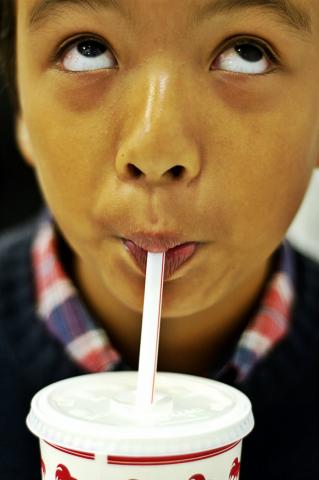
Despite some improvements in recent years, a new report by the UConn Rudd Center shows that beverage companies have a long way to go to when it comes to how they're targeting our kids, and backing parents up as we make healthy decisions for our families.
Parents know: sugary drinks pose a massive public health threat to our families. They're the leading source of empty calories in kids diets [1,2], and each additional 8-ounce serving of a sugary drink increases a child's risk of being obese by 60% [4]. Research shows that seeing ads for these products increases our consumption for them [5], and cultivates life-long customers [6].
The report finds that U.S. households spent $14.3 billion on sugary drinks in 2013, compared to $10.7 billion on 100% juice, plain water, diet soda and other diet drinks. Although gallons of soda purchased went down during this period, gallons of flavored water, sports drinks, and ready-to-drink coffee and tea consumed increased.
That's all exactly as companies have intended. Beverage companies spent $866 million on advertising across all media in 2014. 31% of all drink advertising in 2013 promoted soda and 18% promoted energy drinks. Conversely, advertising for 100% juice and water represented 10% and 4% of advertising.
And they continue to market products that don't make sense for our kids. The majority of children's drinks remain high in sugar, and there were no changes in the overall nutritional content of products offered by sugary drink brands since 2011. Thirty-six percent of children's products contained zero-calories sweeteners, and just 38% of childrens fruit drinks contained juice. Even more shocking: 2/3 of other fruit drinks contained juice. You read that right: products targeted at adults actually had more juice.
Yet parents are misled by claims of nutritional benefits on packaging. Nutrition-related messaging appeared on the vast majority of product labels surveyed, although mainly touting specific ingredients like vitamin C and antioxidants that masked the actual high-sugar content.
Particularly disturbing are details on how companies reach our children, through everything from social media to celebrity endorsements. Some facts:
-
Child-friendly features (like cartoon characters) were present on 29% of sugary drink packages for both kids and regular drinks.
-
Sugary and energy drink ads made up about 2/3 of all television drink ads viewed by kids in 2013. While children across the board saw fewer ads for sugary and energy drinks than in 2010, they still saw 144 (teens), 169 (children) and 287 (preschoolers). And preschoolers and children saw 31% and 23% more sports drink ads, respectively.
-
Brands are turning to social media and third-party websites to push their products, as the influence of their own company sites has decreased. For example, CFBAI companies (i.e. those that have signed onto the industry's marketing self-regulation program) placed more than 46 million ads for sugary drinks that were not approved for advertising to children on children's websites in 2013. And energy drinks and soda brands represented 84% of the 300 million Facebook likes for brands studied, as well as 11 million Twitter followers. Total Facebook followers tripled for regular soda and doubled for energy drinks since 2010.
- Marketing to children of color continues to escalate. The study found tht seven companies spent $83 million to advertise sugary drinks and energy shots on Spanish-language tv in 2013; an increase of 44% since 2010!! Hispanic preschoolers and children saw 23% and 32% more Spanish-language tv ads for sugary and energy drinks over the past three years. And on English-language television, black children and teens saw more than twice as many ads for sugary drinks and energy drinks than white children and teens. For example, black teens saw 4x as many ads for Sprite and 3x as many ads for Coca-Cola than white teens.
So where does that leave us? Although the incredible influence of advertising can feel overwhelming, we have power! As parents, we can push back on how companies target our kids. In 2015, we succeeded in pressuring Burger King and Wendy's to get soda off of kids menus. And we're currently calling on the Children's Food and Beverage Advertising Initiative, the industry's self-regulatory body, to update their recommendations around marketing to kids. And don't forget, our spending counts too! Join us in standing up and speaking out to demand company's improve marketing to kids, and support healthy families and communities.



The views and opinions expressed in this post are those of the author(s) and do not necessarily reflect those of MomsRising.org.
MomsRising.org strongly encourages our readers to post comments in response to blog posts. We value diversity of opinions and perspectives. Our goals for this space are to be educational, thought-provoking, and respectful. So we actively moderate comments and we reserve the right to edit or remove comments that undermine these goals. Thanks!